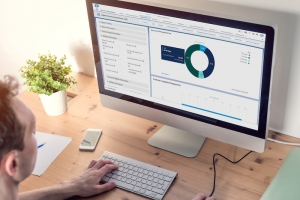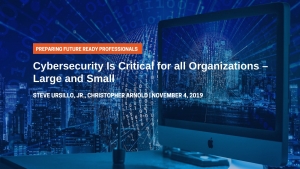عرض العناصر حسب علامة : الذكاء الاصطناعي
اتجاهات التكنولوجيا القائمة على السحابة في شركات المحاسبة
المتطلبات التنظيمية المتطورة هي مجرد جزء من المعادلة عندما يتعلق الأمر باتجاهات الصناعة الناشئة التي تؤثر على مهنة المحاسبة.
معلومات إضافية
-
المحتوى بالإنجليزية
The Three Emerging Cloud-based Technology Trends Transforming Accounting Firms
Evolving regulatory requirements are just part of the equation when it comes the emerging industry trends impacting the accounting profession. Technology and the ongoing innovations in cloud-based solutions are likely to be one of the most transformative forces in your practice over the next three-to-five years.
Research firm Gartner estimates that by 2024 more than 45% of IT spending will shift to cloud-based technologies, and in many instances, this will include accounting software—driving the demand for accountants with strong cloud accounting software skills.
Key to the changing technology landscape for accounting firms is the introduction of new tools with real-time data analytics and artificial intelligence (AI). To thrive in this new technological ecosystem, accounting firms will need to have a clean, reliable, and secure data infrastructure. This may present a challenge for firms that have legacy on-premises systems, not only from a cybersecurity and workflow standpoint, but also in terms of revenue.
This is because it is only by using a new breed of cloud-based accounting systems that firms can open the door to automated financial reporting, cash management, accounts payable, and month-end close processes. The automation of these tasks will increase your firm’s productivity and profitability.
With this in mind, here is a closer look at the three technologies poised to have a lasting impact on the accounting profession: AI, analytics and cybersecurity.
1. Artificial intelligence. Once considered a futuristic technology, AI is now considered by many to be mainstream. There is a growing consensus that AI can and will have a significant impact on just about every industry and business role.
Accounting firms and their clients are already implementing solutions featuring AI to automate mundane, easily repeatable tasks, freeing employees and firm owners to focus their time on higher-value activities.
How will AI impact your firm? Consider this example: using machine learning, a type of AI, a company can feed a year’s worth of expense reports into a travel and expense system with the goal of teaching it to flag anomalies that might indicate fraud or human error. The more reports the system has to study, and the more time it spends analyzing them, the better it becomes at identifying potential issues, creating the opportunity for time and cost savings.
2. Analytics. One of the key advantages of cloud-based technologies incorporating AI and machine learning is the advanced analytics capabilities they offer for users. When more data can be analyzed more quickly with advanced reporting tools, the output is richer and offers deeper insights. This allows accountants to not only save time and increase productivity on data processing functions, but also provides the opportunity to offer additional advisory services and add more value to client relationships.
3. Cybersecurity. Using cloud-based technologies is often more secure than on-premises versions because the right vendor will store all of the client and other data your team has stored in accordance with leading cybersecurity practices most businesses cannot match on their own. In addition, the technology provider will update your solutions frequently in response to emerging security threats. This provides peace of mind to your clients and mitigates liabilities for your firm. Cloud systems also provide the redundancy necessary for business continuity should you need to relocate your firm, work remotely, or face some other business disruption.
It is now a fact: cloud-based technology innovations are disrupting the accounting industry. This trend is quickly transforming what used to seem like futuristic applications and use cases into mainstream solutions. Over the next few years, the technologies described above, along with other developments, will help accountants increase the efficiency of their workflows, access richer data, securely serve their clients, and extract additional insights from every accounting process. The only remaining question is, how will your firm respond?
مواكبة الدور المتطور للمدير المالي
تطور دور المدير المالي في العام الماضي أكثر مما كان عليه في السنوات الخمس الماضية، بسبب التحول الرقمي الهائل الذي حدث استجابة للوباء. بينما تستمر الأرقام -من تلك المرتبطة بمقاييس الأداء إلى المحصلة النهائية -في أن تكون محور التركيز الأساسي، يُطلب من المديرين الماليين اليوم لعب دور رئيسي في قيادة الأجندة الإستراتيجية الأوسع للمؤسسة.
معلومات إضافية
-
المحتوى بالإنجليزية
The role of the chief financial officer has evolved more in the last year than in the past five years, due to the massive digital transformation that took place in response to the pandemic. While numbers — from those associated with performance metrics to the bottom line — continue to be a primary focus, CFOs today are now being asked to play a key role in driving the organization’s broader strategic agenda.
Those agendas increasingly feature digital transformation as companies seek to leverage artificial intelligence, the Internet of Things and other technologies to gain a competitive advantage in a continually changing business environment. And it’s not uncommon to find CFOs at the forefront of these efforts.
A PWC US Pulse survey in August reported that 68% of the finance leaders surveyed plan to invest in digital transformation over the next 12 months. That’s in line with a 2021 Gartner CEO Survey: The CFO Perspective in which 82% of the respondents said there was intent to increase investment in digital capabilities in fiscal year 2021 compared to FY2020.
Streamline the collection process of organizer information with SafeSend Organizers™
Introducing a new optional feature within the award winning SafeSend Suite that automates the front end of the tax engagement
SPONSOR CONTENT FROM SAFESEND
CFOs are creating and executing insight-driven strategies that drive and support technology-powered change throughout the organization, and creating cultures open to new ways of working. Furthermore, CFOs are employing a more holistic view of the business, and championing data-driven decision making, to future-proof the organization and make teams more agile and resilient.
Let’s examine why and how these specific changes to the CFO role came to fruition.
Pandemic-influenced acceleration
While the CFO role has been evolving for years, its expansion into the realm of digital transformation ramped up throughout the pandemic. As COVID-19 lockdowns were imposed, many organizations digitized processes to support remote work operations.
Investments in digital technologies and the supporting information technology infrastructure were essential in enabling these organizations to adapt and thrive amid unprecedented disruptions, and CFOs prioritized the budget for this enablement.
The pandemic also provided a strong proving ground for the value of advanced data analytics. Armed with data, CFOs and finance teams were able to generate insights that enabled the organization to pivot to alternative markets and suppliers and adapt to new ways of working in response to sudden business and market shifts.
The success of those efforts, which includes positive ROI on digital investments, has encouraged many CFOs to advocate for faster and increased digital transformation due to the favorable short-term performance outcomes. CFOs also see the potential for long-term value creation and are making more investments.
The digital transformation of finance functions
Digital technologies aren’t just changing business operations and customer experiences. These technologies are reshaping finance and support functions — and the CFO role.
Automation, AI, machine learning, process analytics and other technologies are being used to streamline workflows and eliminate many tedious, repetitive tasks. That includes manual workflows associated with areas like accounts payable, compliance, and risk management. The results of this evolution are plentiful: increased productivity, less human error, reduced costs, and higher-quality outputs.
The technologies are also freeing CFOs up from the many manual processes that typically take up time, like signing and sending back checks, so the focus can be reassigned to higher-level, more strategic endeavors. It allows for better use of the CFO’s expertise and experience, and allows for the ability to provide greater value to the organization.
In addition, the elimination of manual processes provides CFOs with more bandwidth to create meaningful roles for the finance team. That enables team members to devote more time to high-value activities as well and move past paper pushing, essentially creating a trickle-down effect. It also contributes to greater career satisfaction which can improve employee morale.
Harnessing the power of data
Data analytics have long been used by CFOs and the finance team to help manage business activities. Through digital transformation, CFOs can do much more — and do it all faster and more cost-effectively.
CFOs can easily gather data from numerous disparate sources, clean it, label it, organize it, store it and ensure it meets compliance requirements. With just a click or two, finance leaders can access the data needed, drill down, slice and dice, and perform ad-hoc analyses. This access allows for real-time delivery of insights and the ability to create easy-to-understand visualizations for human resources, sales, procurement, operating divisions, business units and other internal customers throughout the organization.
This data-driven information can be used to develop process improvements, ensure compliance, and enhance employee and customer satisfaction. It can be used to identify new market and profit opportunities, measure and manage business performance, and run simulations. It can help organizations hedge against volatility and respond faster to changes.
Ultimately, the result is that CFOs are becoming data scientists as much as finance professionals. With the ability to interpret data and connect data points, these leaders are also becoming storytellers — including the hows and whys. With this information, CFOs can walk through the steps that are informing decision making behind specific objectives, strategies, and success definitions.
Seeking resilience and readiness
With technology and customer expectations constantly changing and the amount of data growing exponentially, digital transformation is considered an ongoing journey. CFOs are steering efforts to keep forward momentum. Doing so requires continuous innovation and the ability to anticipate, respond and adapt to changes, challenges and opportunities as they arise.
It’s not enough for CFOs to employ the latest technologies or drive company-wide technology adoption. It’s now about striving for digital resilience. Digital resilience enables organizations — and CFOs — to rapidly adapt to business disruptions and capitalize on changing conditions, two factors that should be included in every business continuity plan moving forward.
الذكاء الاصطناعي يقضي على 20 وظيفة قريبا أبرزهم المحاسبين والسائقين
أجريت دراسة سويدية حول التطور التكنولوجي والمهن التي من المحمتل اختفاءها خلال السنوات المقبلة بعد الاستعانة بالذكاء الاصطناعي.
لماذا يعد الذكاء الاصطناعي هو مستقبل المحاسبة؟
بعد عقود من التوقف في مختبرات الأبحاث، أصبح الذكاء الاصطناعي (AI) جاهزًا للظهور في أوقات الذروة، مما يؤدي إلى تغيير إن لم يكن تعطيل جميع قطاعات الاقتصاد التي تولد الكثير من البيانات (البيانات الضخمة)، من التكنولوجيا إلى التمويل والاتصالات والطاقة والرعاية الصحية، التنقل أو التصنيع.
معلومات إضافية
-
المحتوى بالإنجليزية
After decades stuck in research labs, artificial intelligence (AI) is ready for prime-time, transforming if not disrupting all the sectors of the economy that generate lots of data (big data), from tech to finance, communications, energy, healthcare, mobility or manufacturing.
More than most other industries, accounting hasn’t seen much innovation since the creation of double-entry bookkeeping - a process of recording both profits and losses - and considered one of the greatest advances in the history of business and commerce.
That was over 500 years ago!
However, the good news is that applying AI and machine learning technologies to bookkeeping, is becoming a reality with most of the major accounting software vendors (Intuit, OneUp, Sage, and Xero) currently offering capabilities to automate data entry, reconciliations and sometimes more.
PROMOTED
In our upcoming research report on the future of accounting, we expect that by 2020, accounting tasks - but also tax, payroll, audits, banking… - will be fully automated using AI-based technologies, which will disrupt the accounting industry in a way it never was for the last 500 years, bringing both huge opportunities and serious challenges.
Artificial intelligence will not eliminate accountants
“Having machines to do all these tedious and repetitive tasks could sound scary for many accountants because they are also very time-consuming and thus very lucrative,” explained Stephanie Weil, CEO of Accounteam, a Silicon Valley-based accounting firm. “However, if the AI system is well configured, it can eliminate accounting errors that are generally hard to find and thereby reduce our liability and allows us to move to a more advisory role.”
In an upcoming research study, we also tested the automation capabilities of 4 of the most popular AI-enabled cloud-accounting solutions available in the market today (OneUp, QuickBooks Online, SageOne, and Xero) and rank them against our Accounting Automation Index (AAI) which evaluates the accuracy of their AI engines to automatically recognize transactions coming in from bank feeds and generate the correct accounting without any user intervention.
OneUp proved to be the most effective with an Automation Index rate of 95% after 5 months of use, followed by QuickBooks Online (77%), Xero (38%) and SageOne (30%).
Despite being very promising, the accuracy of the machine learning algorithms used in most of today's solutions still needs to significantly improve in efficiency to avoid accounting errors and really fulfill their promise of automation.
اتجاهات المحاسبة في الغد
معلومات إضافية
-
المحتوى بالإنجليزية
In our lifetimes, we’ve all seen technology accelerate every industry it touches. Based on my more than 20 years of experience working in the accounting tech industry, I’ve witnessed this transformation firsthand. Most accountants already use digital tools and are optimizing processes to go paperless. Yet as technology continues to advance and further automate numerous functions, conversations turn to the prospect of human-less accounting.
Will Accountants Be Replaced By Robots?
The short answer is no. Discussions of a robot revolution are honestly more sensational than factual. In the real world, the technologies transforming the financial industry will in no way render the human factor redundant.
Instead, technologies like the cloud, artificial intelligence (AI) and blockchain will empower accountants -- and the entire financial services industry -- by reducing manual data entry and improving the speed, accuracy and quality of data.
PROMOTED
Accountants who embrace the trends below will have a greater capacity to advance their roles as trusted, value-added advisers and analysts -- rather than number-crunchers or the dreaded “bean counter.”
Harnessing The Power Of The Cloud
By 2026, the global market for accounting software will have a value of $11.8 billion (subscription required), according to Accounting Today. Digital is already a given in the accounting industry. With cloud accounting and software-as-a-service (SaaS) applications and the ability to access financial data from any internet-enabled device, virtualization is the new norm.
The growing ecosystem of applications that integrates with accounting platforms has also proven to be efficient by connecting and streamlining back-office processes for a wide range of businesses and industries.
A counterpoint to cloud adoption rates: Neither desktop nor enterprise software will be going away anytime soon. One of the greatest examples of this is while QuickBooks Online reached 2 million subscribers worldwide in 2017, there’s still a substantial user base for QuickBooks Desktop. Of those online subscribers, 80% are first-time users for any kind of accounting software. These users aren’t migrating from desktop to the cloud; they’re starting online. As the target users for QuickBooks Online are small to medium-sized businesses, accountants play a pivotal role in introducing businesses to the cloud.
Accelerating Automation
By 2020, labor-intensive tasks like tax preparation, payroll, audits and banking will be fully automated -- a trend that’s considered the greatest transformation since the introduction of double-entry bookkeeping 500 years ago.
Artificial intelligence (AI) and machine learning won’t make human intelligence extinct. What they’ll actually do is give accountants better access to a range of near-real-time information from a greater number of sources.
For example, a big-picture part of what one of my companies, PayPie, will be doing is using blockchain and smart contracts to exchange secure information between businesses and lenders. AI components will be used to verify the information and ensure that both parties see the information in near-real time.
While algorithms will continue to get more powerful and efficient at compiling big data, computers are only great transactional machines. They can’t replace the interpretive capacity of the human mind. It’s also pretty hard to teach a machine common sense.
Technology will give us access to better data, but accountants are the ones who’ll have to apply this information to the real world to provide crucial business insights and intelligence.
Breakthroughs Via Blockchain
Assuming that cryptocurrencies are the only use for blockchain is like thinking that binge-watching is the only use for online streaming. At the recent Accounting and Finance Show L.A., blockchain (subscription required) and smart contracts dominated conversations.
A single-ledger technology, blockchain is a delivery method that lets users from several sources access the same information in near-real time. For instance, if a business’ risk profile is hashed (tied) to the blockchain, the business and its potential lenders or investors can all access the profile simultaneously.
هل سيكون محاسبك القادم روبوتًا؟
تتقدم العلوم والتكنولوجيا بسرعة باستخدام الروبوتات. في الواقع، يشعر بعض الموظفين بالقلق من اختفاء العنصر البشري تمامًا من أدوار العمل الرئيسية. في عالم المال، تستعد برامج المحاسبة لتصبح أسرع وأقل تطلبًا للعمالة في السنوات العديدة القادمة.
معلومات إضافية
-
المحتوى بالإنجليزية
Will Your Next Accountant Be A Robot?
Jan 14, 2019 | C-Suite, Salesforce Account Executives, Technology Innovation
facebook sharing buttontwitter sharing buttonlinkedin sharing buttonsharethis sharing button
Science and technology are rapidly advancing with the use of robots. In fact, some employees are worried about the human element disappearing completely from key business roles. In the financial world, accounting software is poised to become even faster and less labor demanding in the next several years.
One thing remains certain, as accounting technology evolves, so will the role of the accounting team. However, there remains a need for actual accountants to make sense of finances, even in the midst of innovation.
a man looking at an accounting seed business report
The Tools of Change
Instead of thinking that technology will eliminate or reduce human involvement, look at it as a resource that expands the scope of the financial expert. Accounting practices haven’t dramatically changed in the last few years, but technology has revolutionized how efficiently accounting processes can be done. For an accounting team, remaining valuable means embracing the tools of the future including automation, the cloud, and artificial intelligence.
Automation allows software to streamline key accounting processes such as billing and payments because human interface is heavily reduced, eliminating the need to re-enter data to produce repeatable tasks. This minimizes the workload, increases data integrity, and makes tasks related to bookkeeping easier. Due to this advantage, automation will continue to increase. In a report by Accenture, it’s estimated that by 2020, 40 percent of transaction accounting will be automated. However, recording transactions is only one aspect of the accounting team’s role. Another crucial role of the accounting team is that of advisors, using the information gained from financial transactions to provide insight which can improve business strategy.
As automation progresses, the repetitive aspects of journal entries become faster and less reliant on human action, but this means that financial experts can work faster too. Accounting teams will spend less effort putting in the numbers and more time analyzing them.
The Cloud
The Cloud is already a leading innovation as more and more companies rely heavily on cloud-based applications and services. In the same report compiled by Accenture, up to 85 percent of CFOs are planning future investments in the cloud. Cloud-based platforms and applications will continue to surge in popularity, overtaking older legacy systems because of their flexibility, speed, and accessibility, as well as their ability to be quickly upgraded. We will see core functions like analytics and reporting shift even further towards cloud computing programs, which includes accounting. This is happening now and will continue to accelerate, giving accounting teams more tools and opportunities to work with.
The cloud lets financial data be accessed by staff anywhere, collected from other cloud-based software, and stored in a single solution, like Accounting Seed. This gives businesses more control over their financial management while expediting the process as a whole. Finances can be updated and managed all online and in near real-time through automation too. The cloud will be a major vehicle in helping accounting teams get results closer and closer to actual real-time which will become a major demand for business leaders. As more businesses use the cloud, and automation continues to improve, accounting teams can optimize their workflow and provide better insight because the key information will be more readily available.
Artificial Intelligence (AI)
Artificial Intelligence (AI) continues to show it’s prominence in the next generation of business software. In the accounting world, we’ll likely to see this increase through such technology as Robotics Processing Automation (RPA). RPA is software that combines machine learning capabilities and AI to automate rule-based processes. This can range from processing transactions to generating automatic responses. The ability for a program to self-learn improvement opportunities or prevent mistakes is desirable in accounting as it reduces the amount of time spent on basic processes of transaction recordings and distributions. This doesn’t render accountants useless. Rather, AI helps financial experts do their job more efficiently because no time is wasted. AI makes the job faster, it doesn’t destroy it.
You’ll Still Need Accountants
Ultimately, accounting software is a tool. You still need to know how to use it, and even then, it requires detailed analysis to make use of the data. As technology develops, the technical aspects of accounting become easier and faster, but this simply means the accounting team can serve more a group of guides or consultants (which is ultimately what you really want).
Total reliance on AI or other technology, in general, is not the solution for progress. Removing the insights of human accountants is unwise. Even with the raw processing power of an automated, cloud-based system, good direction from the human is still necessary. Software can’t yet define strategies for cutting costs or provide insight into how to conserve more revenue to reach business goals. It’s up to the accounting team, harnessing the technology, to be the brains behind the machine.
The Evolution of Accounting
With the accounting team’s role evolving more towards analysis and strategy, accountants will need to collaborate more closely with different professionals such as software specialists. In addition to financial analysis and advising, accounting work may grow to report on the effectiveness of tools and individuals in gathering financial data or for quality control. The accounting business will change, but this has the potential of expanding the role of accountants. For the accountant team, mastering the latest technology trends and embracing innovation will empower their career to new heights and ensure their continued relevance.
نصائح حول الانتقال الوظيفي لـلمحاسب القانوني ومتخصصي الضرائب
اليوم وبعد مرور أكثر من عام على انتشار الوباء، يشهد الاقتصاد تقدمًا وقد اقترب موسم الضرائب من نهايته، وقد يكون العديد من المحاسبين مستعدين للبحث عن فرصتهم الوظيفية التالية.
معلومات إضافية
-
المحتوى بالإنجليزية
Given the new landscape, CPAs and other tax professionals may ask what steps can you take to grow your career and land your next opportunity.
Now that we’re more than a year into the pandemic, tax season has (finally) come to a close, the economy is on the upswing and many accounting professionals may be ready to search for their next opportunity. Here are a few ways CPAs and tax pros can plan their next move.
Sign up for our FREE email newsletter
Don't miss out on our best content.
Enter email address *Enter email address
Sign up
Education is Key
It may seem basic, but education and attaining credentials go a long way in the accounting profession. Those aspiring to explore a new role should consider the education and certification requirements of their chosen path.
For many professionals, getting their CPA license is a goal and part of the natural career progression. Obtaining this certification can qualify you for many different career opportunities, from within an accounting firm to leading a business across industries, as well as to help you stand out to employers and industry recruiters.
Easily File and Deliver 1099 and W-2 Forms Online
Efile4Biz offers all-inclusive print, mail and e-file services for quick, efficient and secure e-filing of 1099 and W-2 forms. Everything is done online, eliminating the need for software or paper forms.
Get started today!
Depending on your long-term goals, you might consider the CMA (Certified Management Accountant), a global certification for management accountants and finance professionals, or working towards your CGFM (Certified Government Financial Manager), a professional certification awarded by the Association of Government Accountants (AGA) that demonstrates competency in skills like governmental accounting at the federal, state, and local levels. Not only do additional certifications give you an advantage on other job applicants but pursuing them ensures that you’re consistently up to date on the latest information and increases your knowledge base.
And the education doesn’t stop there. In today’s job market, a huge differentiator is knowledge of the latest technology, including the cloud, AI and automation, and practical applications for your role. More and more companies are adopting these technologies and weaving them into everyday processes.
As a result, the need to upskill or reskill has dramatically accelerated. By getting ahead and educating yourself on these hard skills like data analysis and ERP adeptness, it’s possible to stand out among a sea of applicants.
Attend Events (Virtually)
Prior to COVID-19, it may not have been feasible to attend an event or conference, due to cost or lack of time travel. This meant that there were fewer opportunities for less experienced or more junior associates to grow and network with industry thought leaders.
Today, attending events looks a little different. In lieu of traditional conferences, many organizations have switched to virtual platforms – making professional development or networking opportunities more accessible for many. By signing up and learning from thought-provoking industry executives, you can gain insights on the future of the industry and what companies are looking for in the leaders of tomorrow.
Attending virtual events is also a great way to network with peers. Many conferences offer scheduled breakout rooms, giving you the opportunity to engage and participate in discussions with peers and industry leaders. Topics may vary, but sharing your insights and ideas could position you as an expert.
Another way to network virtually is to be active on social media. Consider posting your thoughts and what you hope to experience at the event, using specific hashtags and posting on the event page or your own social media channels. By doing so, you have the ability to spark great conversation with other potential attendees and industry peers and to build your own professional network.
After the event takes place, you can also share lessons learned – this could take the form of a social media post or written article that can be shared on platforms like LinkedIn. There is also an opportunity to share your learnings with members of your firm, which with further exemplify your leadership skills.
Continuing To Develop Your Leadership Role With EQ
Many companies have changed the way they hire and onboard employees because of COVID-19. Prior to the pandemic, leaders may have only been assessed by their hard skills, like developing efficient financial reporting methods. But now the leadership profile has taken a turn, focusing on behavior training and a high emotional intelligence (EQ).
In order to take the next step in your career, it’s critical to focus on your emotional intelligence. Leaders in today’s climate need to be able to better connect with teams and employees, as many people want to work in a place where they feel safe.
When looking for a new career or position, you should be prepared to discuss specific moments in time that highlight instances when EQ and ability to connect with others helped move a situation forward.
While this is a skill that’s typically intrinsic, it is possible to develop your EQ through behavior training, practicing self-awareness and actively listening. Today, these are the skills that matter most in the workplace.
Conclusion
While many employers provide professional development and training resources to their employees, it is important that you take your future into your own hands. Immersing yourself in outside learning opportunities, like virtual events, and continuing to educate yourself on the industry and necessary skill sets relevant to today’s times are critical to advancing your career.
When looking to take that next step, make sure you show recruiters your efficiency in hard skills – like those that come with certifications – and knowledge of technology. Second, but equally as important, show them the soft skills that make you stand out from other applicants – like your willingness to stand up and share lessons learned and the ability to connect with fellow employees at all levels.
لن تحل الأتمتة محل المحاسب القانوني
معلومات إضافية
-
المحتوى بالإنجليزية
Automation won’t replace CPAs. It will enhance them
By Snehal Shinde
November 24, 2021, 10:36 a.m. EST
4 Min Read
Facebook
Twitter
LinkedIn
Email
Show more sharing options
Artificial intelligence is going to change accounting, but not in the ways that you think.
By now, AI is being utilized in almost every industry. While in some sectors automation could lead to a reduction in the number of jobs, for accountants, its impact is beneficial. If you’re a practicing CPA, rest easy; technology isn’t coming here to take your job, it’s here to make your job better.
Like the previous adoption of calculators or online bookkeeping services, the industry, and those who serve in it, are safe. People still provide what technology and algorithms can’t, particularly trust and client interactions. But technology and algorithms can replace much of the work that no one enjoys doing, while simultaneously freeing up CPAs to become better partners to the organizations they work with.
Streamline the collection process of organizer information with SafeSend Organizers™
Introducing a new optional feature within the award winning SafeSend Suite that automates the front end of the tax engagement
SPONSOR CONTENT FROM SAFESEND
Eliminating the mundane
Whether you’re an accountant just starting out or higher up the ladder, you know that many of the tasks for a new accountant are repetitive and boring. But they need to be done. Items like data entry, reconciliation, adjusting entries and categorizing expenses have long been the responsibilities and bane of the newly employed accountant. Few, if any, enjoy this work.
AI in accounting is significantly reducing — and in some cases eliminating — these tasks. That doesn’t mean less experienced accountants are now replaceable. A person is still needed to verify there are no unintended errors in the data. Someone still needs to make sense of and explain all the data. It means less copy and paste during your workday, not a reduction in hours.
Increased accuracy and efficiency
Many repetitive tasks are prone to human error. When you’re plugging in data all day, it’s understandable: Sometimes a keystroke is missed or an item gets duplicated or put on the wrong line in a spreadsheet. Automating these tasks actually increases the accuracy of reports, while drastically reducing the amount of time necessary to compile them.
Imagine spending an hour each day to verify the numbers, rather than four hours just plugging numbers in. Month-end closing reports can take a couple of hours to analyze rather than 20 to compile. When this type of work is automated, it allows accountants to focus on other types of work, often more creative and strategic.
More, happier clients
Increased efficiency and accuracy have trickle-down effects that boost your bottom line. Accounting practices are limited in the number of clients they can take on based on the amount of time required to input data and create reports. Accountants know there’s no shortage of people looking for their skill sets. With the mundane and time-consuming tasks out of the way, you can actually increase your client base.
It also means you can give more time to each client. Rather than emails piling up and having clients beating down the door to get information and reports, you’ll be able to respond and provide them with what they need quickly. This also allows you to talk to them about more strategic concerns like spend and income rates, trends across periods, and suggestions for future actions. Combine this level of service with more accurate reports and you’ve drastically improved client relationships at the same time you’re taking on additional business.
Less stress at tax time
April and the months leading up to it can seem like an endless pile of receipts, forms, spreadsheets and transactions to categorize to prepare taxes. AI can help with all of that. We’ve already talked about the ability of AI to eliminate data entry and perform reconciliation, but it can do even more than that at tax time.
Automation can ensure that not only are all of the numbers compiled accurately, but the information is optimized for tax purposes. In the future, it will also be able to scan for any available tax credits and integrate with the IRS submission portal.
Accountants and tax professionals will still be needed at tax time, because a human will still need to verify that the numbers make sense and double-check that the technology did its job correctly. They’ll just be able to take on more clients, achieve a bit more balance, and get a better night’s rest during crunch time.
Trust still comes from humans
Automation isn’t here to replace accountants. In fact, AI in accounting is designed to benefit from humans, rather than being standalone. It will shift the nature of your daily tasks, with junior accountants performing more strategic, creative work and senior accountants having more client interaction. In the end, the financial professionals that we work with are more than happy with these changes.
Financial professionals are increasingly relying on technology to help run their practices and perform their duties. The breadth of continuing professional education courses that teach tech solutions is evidence of this. AI is at the forefront of new technology for the industry, and adopting it early will give you an advantage as the industry and client expectations shift. - البلد الأردن
كيف يمكن للحكومات حماية المدن الذكية من تهديدات الأمن السيبراني؟
مع تحرك المدن الذكية نحو الرقمنة السريعة، مع التركيز على التقنيات التخريبية لتطوير بنية تحتية متقدمة لتكنولوجيا المعلومات والنظام، فإن المخاطر المحتملة للهجمات الإلكترونية يزيد معها.
معلومات إضافية
-
المحتوى بالإنجليزية
How can governments safeguard smart cities against cybersecurity threats?
By Samer Omar
EY MENA GPS Consulting Cyber Competency Leader
7 minute read
3 Oct 2021
Related topics
Government and Public Sector Innovation Cybersecurity
Upvote 20
Show resources
EY WGS security by design 2021
Download 2 MB
EY WGS security by design 2021 Arabic
Download 2 MB
As smart cities move toward rapid digitalization, focusing on disruptive technologies to develop an advanced IT and system infrastructure, the potential risk of cyber attacks
increases with it.
In brief
Cities with Inhabitants over 10 million people will increase from 33 in 2018 to a projected 43 in 2030 with a rise to 2.1 billion residents over the age of 60 by 2050.
Smart cities are extensively utilizing new technologies such as artificial intelligence (AI), biotechnology, machine learning, big data, quantum computing and 5G to offer smart services to residents, which in turn has substantially improved their lifestyle and well-being.
The rush to implement disruptive technologies and innovate systems and operations opens smart cities to multiple attack surfaces and vulnerabilities across the city ecosystem; exposing themselves to a growing number of security risks.
In such a scenario, a Security by Design approach is essential to safeguard smart cities and prevent cyber attacks. Security by Design is a new approach to cybersecurity that builds in risk thinking from the onset, enabling global innovation with confidence.
As the number of city residents continues to increase, the demand for rapid expansion and digitalization of urban areas into smart cities has further increased. By 2050, approximately 70% of the world’s population is expected to live in cities. This expansion requires technological and sustainable improvements to balance the social, economic and environmental impacts of these migrations.
The EY Security by Design report covers the challenges, risks and potential solutions for governments to safeguard smart cities from threats and attacks. Although different challenges require differing approaches to the implementation of a digitally enabled ecosystem, the three core considerations during transformation are population risk awareness, effective processes and adoption of disruptive technologies.
The report covers five main topics essential for cybersecurity in smart cities and identifies trends for governments to prepare for including infrastructural improvements, digitalization, population increases, complimentary regulations and agile response teams, and operating models. The five topics are discussed in detail in the EY Security by Design report (pdf):
Disruptive technologies
Security challenges and solutions
Cybersecurity trends
Cyber threat landscape
Government considerations
These components help governments to stay ahead of cybercrime and that they are able to innovate, prioritize and understand the risk landscape and opportunities for security control. These critical areas also ensure that smart cities are initially designed and built with a Security by Design concept in mind.
1
Chapter 1
Disruptive technologies at work
Developing intelligent infrastructure through gathered insights
Governments have harnessed disruptive technologies to improve decision making and enhance efficiency while reducing challenges. The primary benefits include the development of intelligent infrastructure through gathered insights. There are three primary technologies impacting smart cities:
Internet of things (IoT) and sensors: These sensor based technologies gather data which is analyzed for transformative digital implementations. The increased cloud computing usage has led to an increased number of entry points for cyber attackers. Governments must consider data protection politics, defense approaches and security solutions to mitigate risk.
Connected cars: Automotive suppliers face challenges with respect to protections for connected and autonomous vehicles due to lack of regulations. A Security by Design approach would require standardizations and minimum security requirements for manufacturers to implement.
Smart meter and smart grid: These predictive technologies collect large amounts of data through partnerships and need to be protected. Detective, preventative and reformative measures need to be integrated alongside government regulatory frameworks, policies and procedures to help to digitally transform the power infrastructures.
2
Chapter 2
Security challenges and solutions
Exploring innovative strategies to make up for outdated technologies
To ensure sustainable development of smart cities and overcome the challenges of antiquated infrastructure during the rapid urbanization, cities must rethink their innovative strategies to counterbalance outdated technologies.
Estimated cities
00
Will have between 5 and 10 million inhabitants by 2030.
Eight core security challenges have been identified for the consideration of cities across Africa and the Middle Eastern regions:
Insecure hardware: a lack of testing and standardization has let to vulnerabilities to cyber attacks and signal failures.
Linking vision with strategy and policy: a misalignment between strategies, policies and regulations and the vision for smart cities.
Multiple implementation programs: numerous initiatives running in parallel leads to the prioritization of solving logistical challenges and a lack of attention on security vulnerabilities.
Larger attack surface: an increased number of potential entry points for hackers due to the large number of individual devices connected to the network.
Inadequate funding and finance: cities often compensate for reduced budgets by decreasing cybersecurity budgets in favor of large-scale technology investments.
Lack of standardized security architecture: a lack of standardization and communication between city systems and security controls.
Operational Technology (OT) infrastructure security controls: an OT infrastructure that is administered by a generic IT infrastructure.
Deployment of disruptive technologies: a lack of practicality and cost-benefit analysis in adopting disruptive technologies.
Governments need to take an active role in the urbanization and transformation of cities and embed a Security by Design approach into their smart city transformation and technology implementations to reduce the risk of cyber attacks.
They must also establish responsible committees, security initiatives and a multifaceted defense-in-depth approach to protect connected devices while taking note of the potential challenges. In order to develop sustainably, governments must also factor in costs and security architecture design to account for rapid urbanization.
3
Chapter 3
Cybersecurity trends
Knowing the trends to stay one step ahead
EY researchers identified thirteen trends that may pose a challenge to the infrastructure of a smart city:
IT infrastructure improvement
Rise of megacities
Demographic shift
Technology implementations
IoT
Carbon removal solutions
Cybersecurity expertise
Harmonization
Crown jewel identification
Cybersecurity program refresh
Computer emergency response
Laws and regulations
Agile operating model
The most staggering trend is the discrepancy between cybersecurity implementation and smart city digital adoption. According to the IMD Smart City Index Report 2020, security is not considered a priority for top-ranking smart cities, an initiative that should otherwise be inseparable from smart city developments.
4
Chapter 4
Cyber threat landscape
Understanding the entirety of potential and identified cyberthreats
Almost half of corporate boards believe that cyber attacks will harm their business over the next 12 months. In order for smart cities to develop their cybersecurity, they must first understand the threat and risk landscape.
WGS graphic 01
Governments and authorities must consider the types of threats and potential impacts of the attacks and proactively assess and account for cybersecurity safeguards. The EY report identifies three categories of cyber attacks on governments.
WGS graphic 02
5
Chapter 5
Key considerations for governments
Toward safer and sustainable new infrastructures
As new technologies are adopted and smart cities utilize more interconnected systems with single data consolidations, new procedures and regulations are required to ensure the safety and sustainability of new infrastructures.
Governments must account for seven key considerations to maintain a resilient smart city:
Interaction and collaboration: the relationship between cybersecurity and other teams and lines of business
Big data and predictive analytics: considering big data management and the application of security controls to information databases and repositories
Testing environment: mandating the usage of testbeds across all critical infrastructures and new technology systems
Security Architecture: creating standards for architecture based on infrastructure networks, data collection, IT platforms, city structure and service offers
Zero trust and micro segmentation: security procedures to authenticate users and segmentations between cities to mitigate threats
Physical security: Implementation of security cameras in conjunction with AI technology
Public-private partnerships: Government support by the private sector to mitigate the challenges of rapid urbanization
Summary
Today, it has become imperative that governments across the world analyze the importance of having an impenetrable cybersecurity system in place, and disseminate cyber awareness to the masses, to thwart any possible attacks. Staying one step ahead of cybercriminals is the need of the hour, as the world stands battered by the COVID-19 pandemic and is forced to rely on the virtual connectivity across all fields and sectors. The governments need to prioritize assets, understand the risk landscape and implement enhanced levels of security control to better manage and mitigate the forthcoming risks. - البلد الأردن
لماذا يعد الأمن السيبراني أمرًا بالغ الأهمية لجميع المنظمات
معلومات إضافية
-
المحتوى بالإنجليزية
Cybersecurity Is Critical for all Organizations – Large and Small
Steve Ursillo, Jr., Christopher Arnold | November 4, 2019 |
Introduction
In today’s computerized world, new risks emerge every hour of every day. Connecting to the Internet opens up the possibility of a hacker targeting your organization. Cybercrime is becoming big business and cyber risk a focus of organizations and governments globally. Monetary and reputational risks are high if organizations don’t have an appropriate cybersecurity plan.
A ‘Cyber Security Breaches Survey 2018’ revealed that over four in ten (43%) businesses and two in ten (19%) charities in the UK suffered a cyberattack. The survey found that 38% of small businesses had spent nothing at all to protect themselves from cybersecurity threats. A separate survey also found that a third of UK small businesses are risking their online safety by operating at or below the “security poverty line”. The most frequent types of cyber-criminal activity were sending fraudulent e-mails and impersonating organizations online. Malicious e-mails were also found to be the most common type of cyberattack in the Internet Security and Threat Report. The consequences of cyber-crime are costly as the total average cost of a data breach in 2019 is $3.92 million in research conducted by the Ponemon Institute.
What is Cybersecurity?
Cybersecurity is making sure your organization's data is safe from attacks from both internal and external bad actors. It can encompass a body of technologies, processes, structures, and practices used to protect networks, computers, programs, and data from unauthorized access or damage. The goal of any cybersecurity strategy is to ensure confidentiality, data integrity, and availability.
There are several primary means by which cybersecurity issues can affect (or even destroy) an organization and its reputation. There is the risk that a hacker might obtain sensitive information such as bank account or credit cards details. There are open markets for such information on the “dark web”. If others access such sensitive information, the organization might find its banking or credit card facilities withdrawn or in breach of privacy laws. Each month high-profile security breaches impacting individual data are reported globally.
A second but related issue is that when a hacker obtains sensitive information about the organization it may find its reputation ruined. Few small organizations can survive the damage to its reputation that such lost data might cause. The damage to reputation and goodwill might be more crippling than the actual data loss itself. Loss of customer data may result in legal or regulatory action against the organization. A third party might file a suit against an organization as they have themselves incurred a loss. Organizations might also be subject to significant penalties and/or legal action arising from breaches of the privacy laws in many jurisdictions.
The most recent and alarming aspect of cybersecurity that causes considerable problems for organizations is ransomware. As early as 2012, reports of ransomware campaigns have adopted commercially focused business models. In many cases, a piece of malware is disguised and embedded within another type of document only waiting to be executed by the target user. Upon execution, the malware may encrypt the organization’s data with a secret 2,048-bit encryption key or communicate to a centralized command and control server to await instructions carried out by the adversary. Once infected, the organization’s data continues to be inaccessible as the encrypts the data using the attackers encryption key. Once all the data accessible is encrypted, including in many instances the backup data and systems, the organization will be instructed on how to pay a ransom within days, or the adversary will remove the encryption key and the data will be lost. Literally, the adversary holds the data to ransom—hence, ransomware. The encryption key is sufficiently strong enough that cracking the key instead of paying the ransom is uneconomic—some estimate that an average desktop computer would take five quadrillion years to decrypt the data without the key In some cases, the target organization can hope that some researchers may have discovered a way to decrypt the data based on a design flaw. Otherwise the organization will have to look to restore the systems and data from a safe back up or consider paying the ransom. Keep in mind that even data restoration does not eliminate the risk the ransomware will not be reenabled or return based on the compromised integrity of the environment.
Cybersecurity Governance
A cybersecurity governance and risk management program should be established which is appropriate for the size of the organization. Cybersecurity risk needs to be considered as a significant business risk by the owners and directors. This should be at the same level as compliance, operational, financial and reputational risks with suitable measurement criteria and results monitored and managed.
There are voluntary frameworks which can be used to consider the risk assessment and related best practices. For example, the National Institute of Standards and Technology (NIST) Cybersecurity Framework includes five concurrent and continuous functions:
Identify: Develop an organizational understanding to manage cybersecurity risk to systems, people, assets, data and capabilities.
Protect: Develop and implement appropriate safeguards to ensure delivery of critical services.
Detect: Develop and implement appropriate activities to identity the occurrence of a cybersecurity event.
Respond: Develop and implement appropriate activities to take action regarding a detected cybersecurity incident.
Recover: Develop and implement appropriate activities to maintain plans for resilience and to restore any capabilities or services that were impaired due to a cybersecurity incident.
Protection from Malicious Software and External Attack
New threats continue to emerge and each organization needs to be sure it is equipped to deal with a dynamic threat landscape. The following are some of the more critical system utilities and solutions used to help mitigate these malicious attacks:
Firewalls are software (and also hardware) designed to protect the system from attack from people accessing the organization’s systems via both internal and external communication links.
Malware/spyware and web proxy protection solutions protect the system from software code that may be from pop-up windows or have more insidious intent, such as logging usernames and passwords for fraudulent purposes.
Anti-spam software protects email inboxes from being clogged by unwanted broadcasted email.
Anti-phishing software protects users visiting websites that are designed to trap user information that can then be used for fraudulent purposes.
All are mandatory for any well-managed system utilizing a defence in depth strategy. The cost of an attack can be significant, involving loss of data, fraud, and the cost of rebuilding systems and should be analysed against the cost to defend against such threats.
It is recommended to use a well-known, reputable supplier. Some companies purport to supply these utilities but in fact the utilities themselves can be malicious software. Be cautious about using free software or software from an unknown vendor. Generally, it is best to use the utilities recommended by the business’s systems integration (technical support) organization, as they will be responsible for its installation, configuration, and maintenance.
Maintenance of these applications is critical. New malicious software emerges every day. Most software vendors provide at least a daily automatic update to their databases to ensure that the system continues to be effectively protected. Ensuring that these updates are correctly implemented is essential.
Hardware Maintenance Plans
Maintenance contracts should be maintained with hardware suppliers so that hardware failures can be quickly rectified. These contracts should specify the service levels that the supplier will meet in the event of failure. Critical hardware such as servers, switches, and backup technologies require prompt attention. Many contracts specify four-hour response for failure of these components. Other, less critical hardware such as individual workstations can have longer response times.
Some organizations, particularly in remote areas, purchase some critical components that have a higher potential to fail, such as power supplies, as spare parts that can quickly replace a failed component. Organizations that rely on maintenance contracts should ensure that the support company maintains an adequate supply of spare components to meet the organizations service level commitments.
The quality of the organization’s external IT support company is critical in ensuring the systems are correctly implemented and supported. Issues that need to be considered in selecting an appropriate company include:
Their knowledge and experience with the organization’s hardware and operating system configuration.
Their knowledge and experience with the organization’s application software.
Certifications held with major hardware and software companies, which provides an assurance as to the competency of the people in the organization.
The number of people within the company who have the required knowledge to support the system—this is critical as a reliance on a single individual can result in significant delays and cost should that individual be unavailable for any reason.
Their ability to provide support services remotely to enable rapid response to issues at a reasonable cost.
Proper due diligence and vendor risk management to ensure that the third party is providing the services based on the organizations expectations.
People and Documentation
Every organization should establish a plan to mitigate the risk of key people being unavailable in the event of a system failure. Keep a list of contact details for backup technicians. Document the configuration of hardware and software applications and keep this up to date so that a new technician can quickly rebuild the system.
Policies and Procedures
Proper IT governance procedures within an organization are critical. Implement a formal risk assessment process and develop policies to ensure that systems are not misused and ensure that applicable policies are continually reviewed and updated to reflect the most current risks. This includes developing incident response policies and procedures to properly respond to, account for and help mitigate the cost of a potential breach.
Ongoing education to all employees on technology risks should form part of the organizations risk management framework, with potential security breaches being mitigated as a result of education and policies being promulgated to all levels of staff. Policies should include but are not limited to:
User Account Management: rules and policies for all levels of users; procedures to ensure the timely discovery of security incidents; IT systems and confidential data are protected from unauthorized users.
Data Management: establishing effective procedures to manage the repositories, data backup and recovery, and proper disposal of media. Effective data management helps ensure the quality, timeliness, and availability of business data.
IT Security and Risk Management: process that maintains the integrity of information and protection of IT assets. This process includes establishing and maintaining IT security roles and responsibilities, polices, standards, and procedures.
Individual jurisdictions are likely to have enacted legislation that may require particular policies, or issues within a particular policy, to be addressed. Common policies are listed below and cover system use, e-mail use, internet use and remote access.
System Use Policy
A system use policy generally outlines the rules by which the organizations IT systems can be used. Example elements to be considered in this policy include:
Mandatory use of passwords on all systems, such as phones and tablets, including the need for passwords to be changed regularly and a prohibition of providing passwords to other team members or third parties.
Prohibition of copying organization data and removing the data from the office without approval.
The encryption of memory/USB sticks.
The physical security of equipment.
Use of the system during business hours.
Rules for the private use of the system, if allowed, outside office hours.
Multifactor authentication - using more than one method of authentication from independent categories of credentials to verify the user’s identity for login.
Email Use Policy
Example elements to be considered in an e-mail use policy include:
Prohibiting the use of personal email accounts for business matters.
Prohibiting opening email attachments from unknown sources (as they may contain malicious software).
Prohibiting accessing email accounts of other individuals.
Prohibiting sharing email account passwords.
Prohibiting excessive personal use of the organization’s email.
Notification that the organization will monitor email.
Internet Use Policy
Example elements to be considered in an internet use policy include:
Limiting Internet use to business purposes.
Notification of the ability of the organization to track Internet usage.
Prohibiting access to sites that are offensive to a person’s gender, sexuality, religion, nationality, or politics.
Ensuring that downloads occur only from a safe and reputable website.
Prohibiting downloading executable (program) files as they may contain malicious software, and also prohibiting downloading pirated music, movies, or software.
Prohibiting providing the user’s business email address in order to limit the likelihood of spam.
Consequences of violation.
Remote Access Policy
Example elements to be considered in a remote access policy include:
Approvals required for external access.
Reimbursement of external access costs.
Security procedures (including disclosure of passwords, third-party use of system, disconnection from other networks while accessing the organization’s systems, use of firewalls and installation of appropriate software to protect the remote system from malicious attack and multifactor authentication).
Physical security of organization-supplied equipment such as laptops.
Reporting of any possible breach of security, unauthorized access, or disclosure of the organizations data.
Agreement that the organization can monitor the activities of the external user to identify unusual patterns of usage or other activities that may appear suspicious.
Consequences of noncompliance.
Insurance
Adequate insurance should cover the cost of replacing damaged infrastructure as well as the labor costs to investigate the incident, rebuild systems and restore data. Consider also insurance for productivity loss resulting from a major system failure or catastrophic event.










